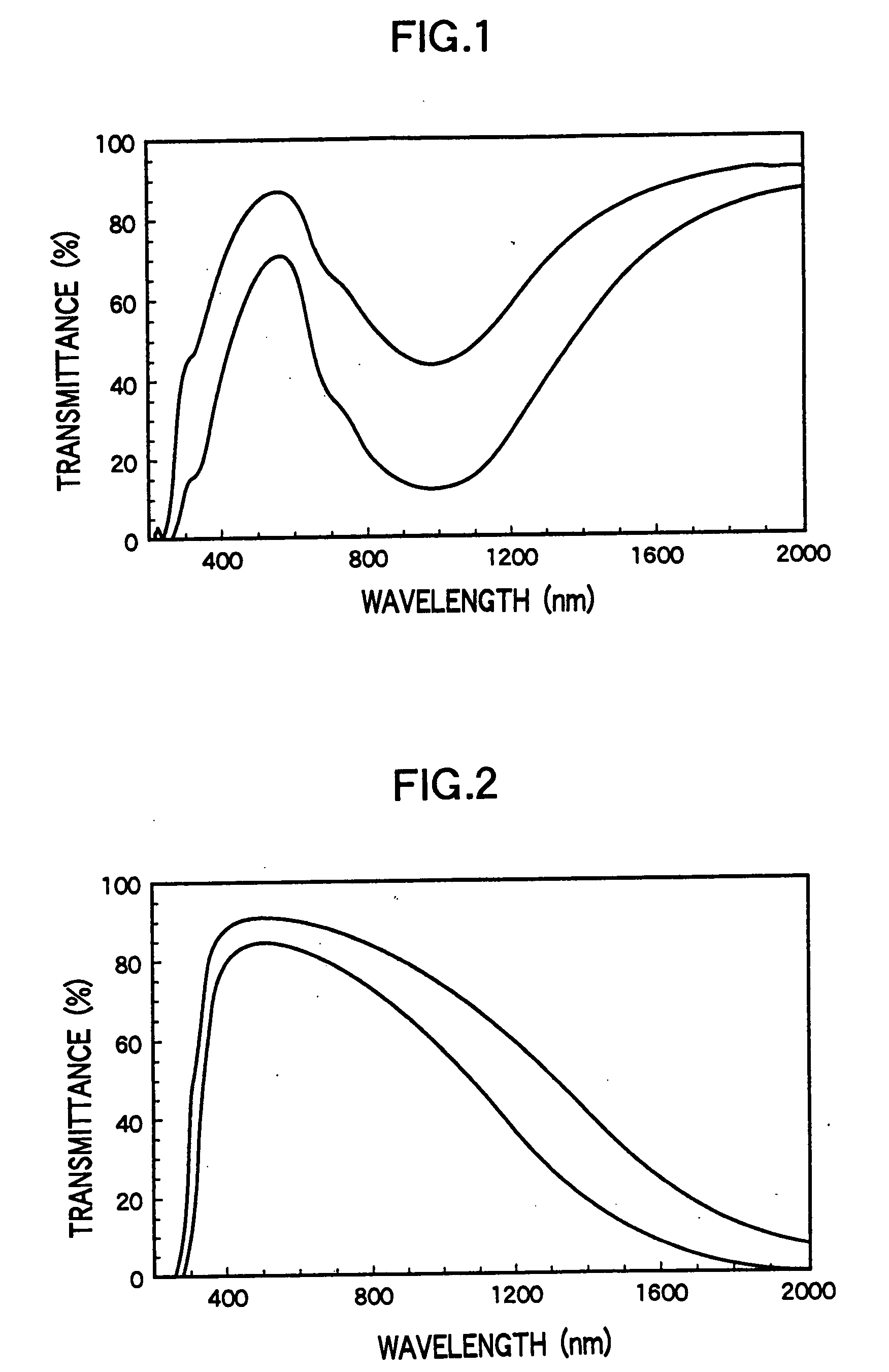Heat-insulating material for agricultural or horticultural facility
a technology horticultural equipment, which is applied in the field of heat shielding material for agricultural and horticultural equipment, can solve the problems of affecting the quality of horticultural equipmen
- Summary
- Abstract
- Description
- Claims
- Application Information
AI Technical Summary
Problems solved by technology
Method used
Image
Examples
example 1
[0043] 20 Parts by weight of LaB6 fine particles (specific surface area: 30 m2 / g), 75 parts by weight of toluene, and 5 parts by weight of a dispersing agent were mixed to obtain Dispersion A in which the fine particles of LaB6 with an average dispersed particle diameter of 80 nm had been dispersed. From this Dispersion A, solvent components were removed at 50° C. with a vacuum dryer to obtain dispersion-treated Powder A of LaB6. Here, the average particle diameter noted above is an average value obtained by measurement on a measuring device using a dynamic light scattering process (manufactured by Ohtsuka Electronics Co., Ltd.: ELS-800).
[0044] 0.01 Kg of this Powder A of LaB6, and 8.7 kg of low-density polyethylene resin pellets were dry-mixed in a V-blender. And then, internal mixing was thoroughly carried out in the vicinity of 110° C. in the neighborhood of the melting temperature of the low-density polyethylene resin, and this mixture was extrusion-molded at 110°0 C. to form a...
example 2
[0048] 0.005 Kg of Powder A of LaB6 prepared in Example 1 above, and 8.7 kg of low-density polyethylene resin pellets were dry-mixed in a V-blender. Then, as in Example 1, internal mixing was thoroughly carried out at 110° C. in the neighborhood of the melting temperature of the low-density polyethylene resin, and this mixture was extrusion-molded at 110° C. to form a film having a thickness of about 50 μm. The content of the LaB6 fine particles in this film is equivalent to 0.065 g / m2.
[0049] The film-like heat shielding material thus obtained was evaluated as in Example 1. The visible light transmittance was 82%, and the solar radiation transmittance was 68%. The difference between the visible light transmittance and the solar radiation transmittance was 14%. The heat shielding material was sufficient to transmit light in a visible light region, and at the same time, capable of screening 32% of direct incident light arising from sunlight. Thus, this heat shielding material has bee...
example 3
[0050] In Example 2 above, except that polypropylene resin pellets were used in place of the low-density polyethylene resin pellets, and the heating temperature was changed to a temperature (about 240° C.) at which the polypropylene resin became sufficiently softened, a film was formed by the same method as employed in Example 2. The content of the LaB6 fine particles in this film is equivalent to 0.065 g / m2, which is equal to that in Example 2.
[0051] The film-like heat shielding material thus obtained was evaluated as in Example 1. The visible light transmittance was 80.9%, and the solar radiation transmittance was 65.7%. The difference between the visible light transmittance and the solar radiation transmittance was 15.2%. The heat shielding material was sufficient to transmit light in a visible light region, and at the same time, capable of screening about 34% of direct incident light arising from sunlight. Thus, this heat shielding material has been found to have an improved he...
PUM
| Property | Measurement | Unit |
|---|---|---|
| solar radiation transmittance | aaaaa | aaaaa |
| solar radiation transmittance | aaaaa | aaaaa |
| solar radiation transmittance | aaaaa | aaaaa |
Abstract
Description
Claims
Application Information
 Login to View More
Login to View More - R&D
- Intellectual Property
- Life Sciences
- Materials
- Tech Scout
- Unparalleled Data Quality
- Higher Quality Content
- 60% Fewer Hallucinations
Browse by: Latest US Patents, China's latest patents, Technical Efficacy Thesaurus, Application Domain, Technology Topic, Popular Technical Reports.
© 2025 PatSnap. All rights reserved.Legal|Privacy policy|Modern Slavery Act Transparency Statement|Sitemap|About US| Contact US: help@patsnap.com

